The 2018 Martian Global Dust Storm
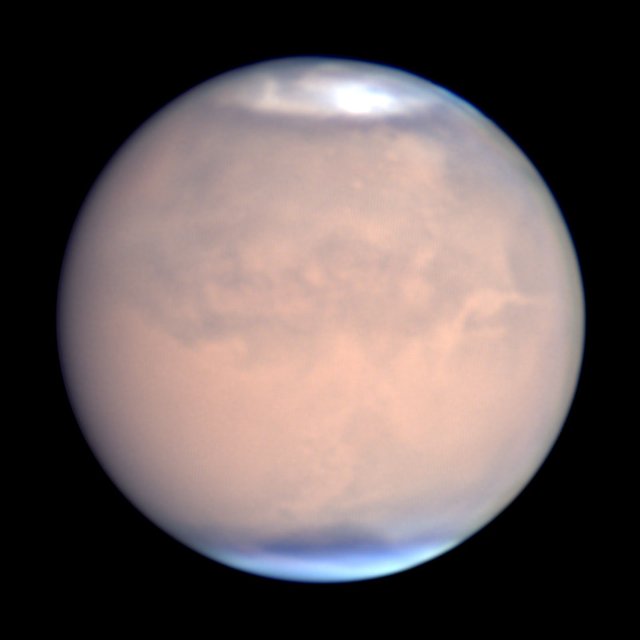
On July 18, 2018, the author got this image of Mars showing a slight clearing of the extensive dust storm that has covered the majority of the planet. As the storm clears some detail is returning. The South Polar cap is visible at the top and north polar clouds at the bottom. The giant canyon Valles Marineris is visible as a light horizontal marking right center on the planet.
Last month I wrote about a developing dust storm on Mars, and since then the storm has grown to cover most of the planet. The term “storm” is a bit of a misnomer as even though the strongest winds reach 100 kph, the atmosphere is so thin it would feel no more like a very gentle sea breeze. This light breeze is however strong enough to lift large amounts of fine dust into the sky causing the Martian skies to become opaque. One consequence of this is that the Mars landers need to hibernate during a dust storm as the ability to recharge from solar energy is greatly diminished. Yet another consequence is detail on the planet almost vanishes from view for earth-based observers.
Backyard astronomers like myself can monitor the development of these dust storms, particularly during favorable approaches of Mars to the earth as is the case right now. Advances in technology, particularly in the areas of imaging and imaging processing have meant that amateur astronomers are now routinely capturing images as good, perhaps even better than early spacecraft images. I managed to get the following image sequence showing the Martian surface in the process of being obscured by the growing dust storm.
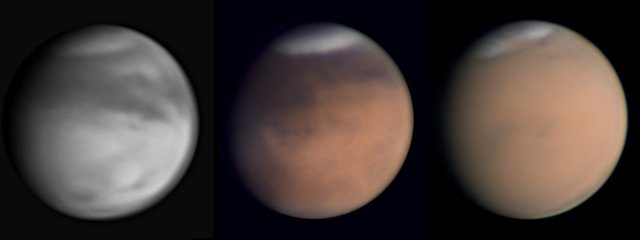
This sequence of 3 images of Mars by the author from May 19, June 1 and June 12, show how the dust storm progressed and obscured nearly all the surface detail
During July there appear to be indications of the dust slowly settling and I was able to get images on several nights with examples provided here. Note that viewing conditions vary a lot, and some nights are better than others, so the resolution varies a bit between them.
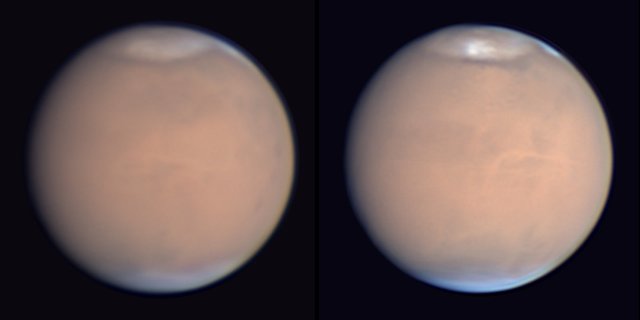
Left Image is July 10, giant volcano Olympus Mons is one of the dark spots near the righthand limb of the planet. Right image is July 12, and clearly shows the polar caps and Valles Marineris (J-shaped light feature right of center)
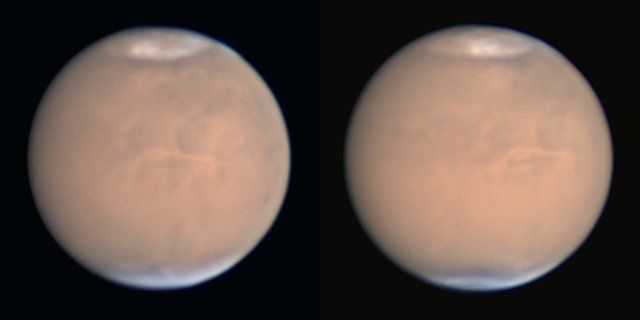
Images from July 14 (left) and 17 (right). Note Valles Marineris is visible as the light linear feature near the middle (the shape reminds me a bit of a gun
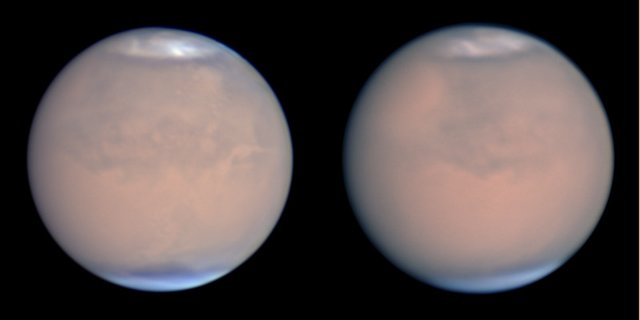
Images from July 18 (left) and 19 (right)
Large dust storms like this appear to occur every three years on Mars; typically they occur when Mars is closer to the sun. The dust storm itself will choke the surface heating from the sun, which in turn cuts of the storms power source – so they subside. The subsidence of the dust storm appears to be happening now, as surface detail on the planet is starting to reappear. Dust transport seems to be a major contributor to the shaping of the Martian landscape, and even without the dust storms, this happens on a more localized scale by large numbers of dust eddies that cross the landscape as shown in the image below. Please take the time to view this ESA link showing remarkable images of a dust storm front.
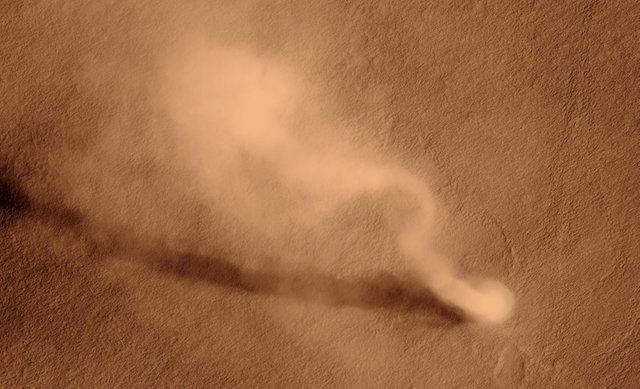
Raised dust can be seen in a Martian Dust Devil. Image Credit: NASA/JPL/MSSS
Hunting down the Martian Moons
In addition to observing the planet, Mars has two tiny moons called Deimos and Phobos. These moons are notoriously difficult to see as they a faint any close to the planet which overwhelms them with it’s glare. The author got this time lapse of the Martian moons over the space of 16 minutes on July 19. The planet itself is heavily overexposed in the center, while the larger moon Phobos is at the left, and Deimos is at the right.

The moon Phobos is the moving star on the left, likewise Deimos is on the moving star at the right. Mars is the bright red object in the center (it is heavily overexposed).
Looking Out for Mars
Mars is closest to us on July 31 and will remain well placed for viewing throughout August. The brightness of the planet is impressive now, even from suburbs, with it appearing as a very bright orange star in the east during the evening. It will be another 19 years before we get a closer approach to Mars, so you should make the best of this opportunity. A small, inexpensive telescope will show as a small orange disk, with larger telescopes showing the polar caps and markings.
My Setup
Finally, I get a lot of questions about my setup and so here are a few more details.

Imaging Mars with a C14 telescope. This telescope was used to obtain the images in this article
The equipment I have is quite obtainable (maybe not cheap, but still less than a new car) and capable of doing a lot of useful and interesting observations even from my suburban site. The telescope is a Celestron C14HD, which has an aperture of 14” (36cm) which makes it a medium/large telescope for amateur use. The design is a called a Schmidt-Cassegrain telescope or SCT for short and combines refracting and reflecting telescopes to enable it to have a very short tube for the size of the telescope (see diagram below). For the images in this article, I used the telescope with a Barlow lens which increases the focal length of 7000mm! Incidentally, this focal length is 10x greater than the biggest telephoto lenses available (like the ones you see birdwatchers or professional sports photographers use). Of course, there is no autofocus, and you would need superhuman strength to cart it around a sports match!
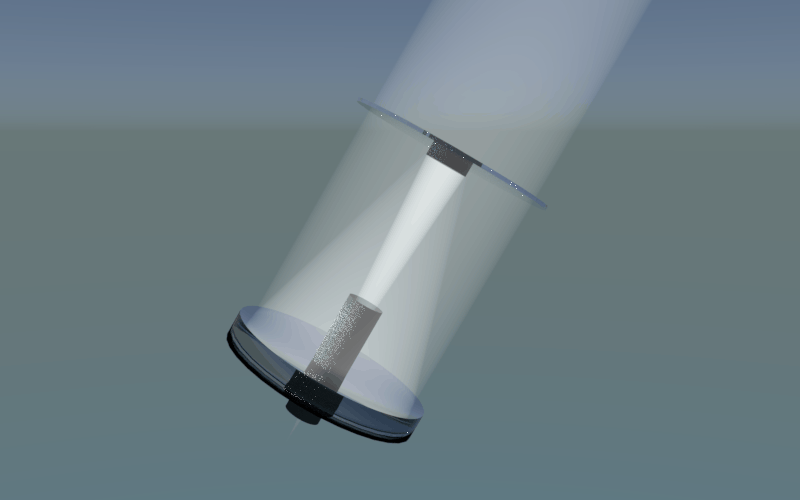
Schmidt-Cassegrain telescope, has two spherical mirrors with an aspheric corrector plate. This design has advantages of being compact. The animation done in Blender 2.79b.
The mount is a Celestron CGEM-GX which is a little small for the size of the telescope which means it is not as physically stable as I would like and limits some of the astrophotography I do. However, it mostly does the job, but it is definitely on the future upgrade list. However heavy-duty mounts are quite expensive. The camera I used here is a QHY183c, a color camera designed for astronomy using a Sony IMX-183CQJ (as used in several digital cameras) but optimized for astronomy. I will talk about this camera in a future article.
References and Further Reading
- https://mars.nasa.gov/news/8348/opportunity-hunkers-down-during-dust-storm/
- https://www.dlr.de/dlr/en/desktopdefault.aspx/tabid-10081/151_read-28965/#/gallery/31422

SteemSTEM is a community project with the goal to promote and support Science, Technology, Engineering and Mathematics on the Steem blockchain. If you wish to support the steemSTEM project you can:
Contribute STEM content using the #steemstem tag | Support steemstem authors | Join our curation trail | Visit our Discord community | Delegate SP to steemstem
Excellent and informative read, Terry :-)
Unfortunately, I must wait for the next Mars opposition. But then I hopefully own an instrument with more aperture and focal length.
The C14HD is a very impressive telescope.
I do not want to imagine what it takes for arms to be able to take pictures of the sports match with this monster. :-D
Thanks Kevin, the next opposition of Mars will be a bit more distant for this one but I guess it will also be higher in the sky for you.
You're welcome Terry :-)
In any case, there is still enough time to get a bigger telescope and to practice the imaging of planets. The height in the sky is always a problem. The closer to the horizon the more disturbances.
Even at 45 degrees up I notice several pixels of dispersion of the Red, Green and Blue image planes as well. So I find I have to realign the color channels at the end of processing.
I have the "luck", that I have some other houses around me, so I can not so close to the horizon. Fortunately, I had no shifts between the colors until now. But I think that will be due to the short focal length and the relatively slow telescope
This post has been voted on by the steemstem curation team and voting trail.
There is more to SteemSTEM than just writing posts, check here for some more tips on being a community member. You can also join our discord here to get to know the rest of the community!
Nice telescope! I wonder how much exactly it's cost? I have been fascinated with space and anything related to it since primary school but now, I don't know where to start. Any idea?
This is the same telescope with a similar mount here . In reality this is too heavy for portability (without risking injury) so it had to be mounted permanently. I would start with an 8" Dobsonian telescope, but smaller scopes give very satisfying views as well. I had a view recently with a very cheap 5" table mount dobsonian telescope and it showed the rings of Saturn without any problem (yes the planet looked small).
Wow... This is a very great work of research. I really commend your hardwork. Nice telescope 🔭you have there. Wish to also get one someday.
Thank you @emperorhassy ! It's a labor of love, if somebody can use the observations then I will be very pleased :)
Quite expository. I particularly love the fact that the images were original. I'm definitely trying out a way of catching a view of Mars.
I really enjoyed reading this... Kudos
Thank you @obamike and yep those images are original 👍
Beautiful Instrument. Ive had a very beginner telescope for many years and I cannot wait to upgrade and view stuff like this on my own! I hope to one day take a picture of the Dumbbell Nebula
Please post your impressions when you do!
Very educative
Something new I learnt from this. How does the two different moons operate?
You are really doing a good work with your set but too bad I don't have knowledge about it I would have love to contribute
I am glad you think I do good work :) How do the two moons operate? Well the moon Phobos which is about 25 km in diameter is less than 9000 km from the surface of the planet and takes less than 8 hours to complete an orbit. Deimos is about 3 times further out and takes about 30 hours to orbit around Mars.
So there is an instrument that can bring life in
Space into my room... Wow!
I wish I can get one celestron C14 telescope before July 31st...
wow bro, u work with some really powerful tools!
Looks like we need to plant some trees to Mars to prevent these storms, lol. A good article bro. Cheers!
Who knows there might have been trees there once upon a time!
may be!
Hi @terrylovejoy!
Your post was upvoted by utopian.io in cooperation with steemstem - supporting knowledge, innovation and technological advancement on the Steem Blockchain.
Contribute to Open Source with utopian.io
Learn how to contribute on our website and join the new open source economy.
Want to chat? Join the Utopian Community on Discord https://discord.gg/h52nFrV